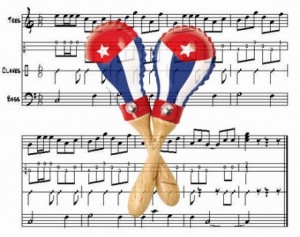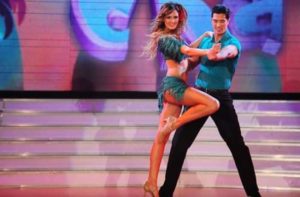 EL RITMO MUSICAL “CHA- CHA- CHA! … CUANDO CUBA TENIA 100 EMISORAS RADIALES ..
EL RITMO MUSICAL “CHA- CHA- CHA! … CUANDO CUBA TENIA 100 EMISORAS RADIALES ..
Prado y Neptuno es una intersección de dos populares calles de la vieja Habana, fue precisamente allí en uno de los locales de las Asociaciones “Silver Star” y “Prado y Neptuno” en el salon ‘Amores de Verano’ que se ejecutó por primera vez un ritmo musical que comenzaria toda una epoca del fenomeno ritmico cubano llamado “cha-cha-cha..
A este milagro musical que desde entonces se llamó cha-cha-chá propulso a su su creador el director musical de la Orquesta America y su primer violinista, el maestro Enrique Jorrín, a una fama nacional y dejando inscrito, más que un género, su sello propio, colocandolo entre las glorias de la Música cubana.
En aquel entonces en Cuba había 10.000 vitrolas, alrededor de 100 emisoras de radio, varios canales de televisión —por donde se emitían magníficos programas como “El Cabaret Regalías” de la CMQ— y un sinnúmero de locales y establecimientos donde se reunía el pueblo para escuchar música y bailar.
Su primer numero musical de este ritmo nuevo “La Engañadora”, escrito por Jorrín, deja en pocos meses impreso en los anales nacionales, y después en todo el mundo, el sello propio de esta gloria de la música cubana que fuera el maestro Enrique Jorrín.
“A Prado y Neptuno
iba una chiquita
que todos los hombres la tenían que mirar…
Un ritmo pegajoso y atractivo el cha-cha-chá, según explica el mismo Jorrín… En él “combiné figuras simples, como las negras, blancas y corcheas en compás de 2/4. Suprimo el cinquillo, convirtiendo el ritmo básico del género al esquema no sincopado ejecutado por el guayo, el cencerro y la tumbadora”.
A medio siglo del triunfo mundial del cha-cha-chá, echemos una ojeada sobre este ritmo popular que recorrió el mundo e inmortalizó a una de las esquinas más famosas de La Habana, y que puso a La Habana otra vez en la cadencia musical de sus intérpretes y bailadores desde Buenos Aires hasta Tokio, donde el maestro Enrique Jorrín lleva su música.
¿QUIEN FUÉ LA ENGAÑADORA..?
¿De dónde salía aquella mujer que puso el mundo a gozar y convirtió a la famosa esquina Prado y Neptuno en el foco musical de toda una época..? ¿Cuál es el origen de la Engañadora..?
Según algunas fuentes, el maestro Jorrín se inspiró en una muchacha que un día pasó ante él y un grupo de hombres que conversaban en la esquina de las calles Infanta y Sitios, en La Habana. Ante el desprecio con que la muchacha les miró, uno de los admiradores le dijo: “Tanto cuento y cuando viene a ver son de goma”. En otra ocasión en que Jorrín se encontraba en el desaparecido salón de bailes situado en la esquina de Prado y Neptuno, entró una muchacha delgadita pero que ostentaba un voluminoso trasero. Una moda artificial muy usual en la época. Enseguida le pasó por la mente la pregunta: “¿Esta será otra engañadora? ¿Usará postizos?”.
Otras fuentes dan como inspiración de “La Engañadora” a Manolo Maylán (un famoso travesti cubano). Maylán fue objeto en la ciudad de Miami de un “incidente de confusión” por parte de un ciudadano norteamericano que, cultivado por sus “virtudes femeninas”, le propuso matrimonio. Al enterarse de la verdad, el confundido pretendiente la quiso emprender a tiros contra Maylán… Simplemente se trataba de “un hombre confundido”, manifestó Maylán ante preguntas de los periodistas de la prensa habanera que recogieron el incidente como “un drama pasional”.
Lo cierto de todo esto es que el ritmo y “La Engañadora” conquistarían en poco tiempo todo el continente, el mundo bailaba el majestuoso cha-cha-chá, que hoy se mantiene saludable, lleno de vida y de energía como sólo un ritmo del trópico y la creación del maestro Jorrín pudieran alcanzar.
Hace apenas unos pocos años que dejó de existír en Pueblo Nuevo, La Habana, Agueda Álvarez, a quien se le considera la bailarina que inventó los pasos del cha-cha-chá: uno, dos, tres; cha… cha… chá, y que sirvió como la primera modelo de “La Engañadora”, acompañando en teatros y salones de baile alrededor del mundo a la Orquesta América y a Enrique Jorrín.
“Pero todo en esta vida,
Se sabe, sin siquiera averiguar,
Se ha sabido que sus formas,
Rellenos tan sólo hay….
“La Engañadora” fue el primer triunfo del maestro Jorrín grabado con el sello Panart, compañía que pasaba por problemas financieros en esos momentos. La grabación traía del otro lado “Silver Star”, que acompañó triunfalmente también al nacimiento del nuevo ritmo.
Al igual que Jorrín, muchos intérpretes de la música cubana ya no están entre nosotros, pero los recuerdos de su herencia musical para siempre estarán aquí. Nuevas generaciones ocuparán nuestros puestos bailables, es precisamente para que esto continúe sucediendo, motivo principal de este sentido y merecido homenaje a la memoria del maestro Enrique Jorrín.
 THE MUSICAL RHYTHM “CHA- CHA- CHA! … WHEN CUBA HAD 100 RADIO STATIONS…
THE MUSICAL RHYTHM “CHA- CHA- CHA! … WHEN CUBA HAD 100 RADIO STATIONS…
Prado y Neptuno is an intersection of two popular streets of old Havana, it was precisely there in one of the premises of the “Silver Star” and “Prado y Neptuno” Associations in the ‘Amores de Verano’ room that was run for the first time a musical rhythm that would begin an entire epoch of the Cuban rhythmic phenomenon called “cha-cha-cha…
This musical miracle since then was called cha-cha-chá its creator, the musical director of the Orquesta America and its first violinist, the maestro Enrique Jorrín, who left his own label, more than a genre, and that he would place among the glories of Cuban Music.
Back then in Cuba there were 10,000 vitrolas, around 100 radio stations, various television channels — where magnificent programs such as CMQ’s “El Cabaret Regalías” were broadcast — and countless venues and establishments where the people gathered to listen to music and dance.
His first musical number of this new rhythm “La Engañadora”, written by Jorrín, leaves in a few months printed in national annals, and later throughout the world, the hallmark of this glory of Cuban music that was the maestro Enrique Jorrín.
A catchy and attractive rhythm cha-cha-chá, as Jorrín himself, explains … In it “I combined simple figures, such as black, white and eighth notes in 2/4 time. I remove the cinquillo, converting the basic rhythm of the genre to the non-syncopated scheme executed by the guayo, the cowbell, and the tumbadora ”.
Half a century after the world triumph of cha-cha-chá, let’s take a look at this popular rhythm that traveled the world and immortalized one of the most famous corners of Havana, and that put Havana again in the musical cadence of its performers and dancers from Buenos Aires to Tokyo, where the maestro Enrique Jorrín carries his music.
WHO WAS THE DECEIVER (LA ENGAÑADORA”)..?
Where did that woman come from who made the world enjoy and turned the famous Prado and Neptune corner into the musical focus of an entire era? What is the origin of the Deceiver ..?
According to some sources, the teacher Jorrín was inspired by a girl who one day passed before him and a group of men who were conversing on the corner of Infanta and Sitio streets in Havana. Faced with the contempt with which the girl looked at them, one of the admirers told her: “I count so much and when you come to see they are made of rubber.” On another occasion when Jorrín was in the disappeared dance hall located at the corner of Prado and Neptuno, a slim girl entered but had a voluminous butt. A very usual artificial fashion at the time. Immediately the question crossed his mind: “Is this another deceiver? Will you use hairpieces? ”
Other sources give Manolo Maylán (a famous Cuban transvestite) as inspiration for “La Engañadora”. Maylán was the object in the city of Miami of an “incident of confusion” on the part of a North American citizen who, cultivated by his “feminine virtues”, proposed to her. Upon learning the truth, the confused suitor wanted to shoot her against Maylán … It was simply “a confused man,” Maylán said when asked by journalists from the Havana press who described the incident as “a passionate drama.”.
The truth of all this is that the rhythm and “La Engañador” would conquer the entire continent in a short time, the world danced the majestic cha-cha-chá, which today remains healthy, full of life and energy as the only rhythm of the tropic and the creation of the master Jorrin could achieve.
Just a few years ago, Agueda Álvarez, who is considered the dancer who invented the steps of cha-cha-chá, ceased to exist in Pueblo Nuevo, Havana: one, two, three; cha … cha … chá, and who served as the first model of “La Engañadora”, accompanying the Orquesta América and Enrique Jorrín in theaters and dance halls around the world.
“La Engañadora” was the first triumph of maestro Jorrín recorded with the Panart label, a company that was going through financial problems at that time. The recording brought “Silver Star” on the other side, which also triumphantly accompanied the birth of the new rhythm.
Like Jorrín, many interpreters of Cuban music are no longer with us, but the memories of her musical heritage will always be here. New generations will occupy our dance positions, it is precisely for this to continue happening, the main reason for this sense, and deserved tribute to the memory of the teacher Enrique Jorrín.
Agencies/ Arnoldo Varona/ Internet Photos/ YouTube/ www.TheCubanHistory.com
THE CUBAN HISTORY, HOLLYWOOD.













